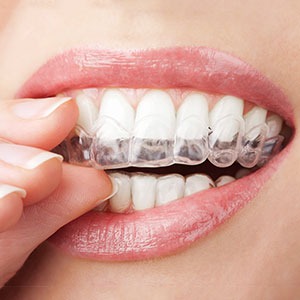 More than 1.5 million people have had their misaligned teeth corrected by Invisalign1. The breakthrough teeth straightening system offers a viable treatment option for mild to moderate orthodontic issues. Instead of the traditional wire-and-bracket type of braces, Invisalign offers removable aligners that are made from smooth BPA-free plastic. Given that they are much less noticeable in the mouth as compared to traditional braces, they have been aptly referred to as invisible braces.
More than 1.5 million people have had their misaligned teeth corrected by Invisalign1. The breakthrough teeth straightening system offers a viable treatment option for mild to moderate orthodontic issues. Instead of the traditional wire-and-bracket type of braces, Invisalign offers removable aligners that are made from smooth BPA-free plastic. Given that they are much less noticeable in the mouth as compared to traditional braces, they have been aptly referred to as invisible braces.
There are many merits to using this alternative system. Needless to say, many people find its cosmetic attributes appealing as well. Invisalign allows you to undergo the treatment in a discreet fashion instead of announcing your dental problems to everyone you come across. The precise computer-aided design of the aligners means they conform to your individual teeth structure in a way that promotes comfort and ease of use. Compared to traditional braces, they also interfere less with your lifestyle habits. The removable devices allow you to eat, brush and floss as you normally would. They also promote better oral hygiene as they do not trap food particles the way wires and brackets often do.
That said, it must be acknowledged that Invisalign is not for everyone. To find out whether you would make a good candidate, the best thing to do is to consult with our specialised dentists at Sydney CBD Dental. During the consultation, you should discuss all the things that you are unclear about so as to determine the best way forward
Nevertheless, here are several points of consideration to help you along the decision-making process:
Severity of misalignment
As mentioned, Invisalign provides a viable solution for mild to moderate bite problems. Unfortunately, it is not designed for severe orthodontic cases that may require more advanced forms of treatment. The common bite problems that Invisalign can help with are as follows:
Gappy teeth: Uneven or wide spaces between teeth
Overbite: Upper teeth protrude out further than lower teeth
Underbite: Lower teeth protrude out further than upper teeth
Crossbite: Teeth not properly aligned with opposing teeth
Crowded: Teeth too close together such that they over
Age matters
Orthodontic braces have always been regarded as a rite of passage for young children. Dentists would normally recommend that kids from as little as 7-10 undergo orthodontic treatment. Invisalign, on the other hand, is suitable for older teenagers and adults. Patients belonging to these age groups can better appreciate the aesthetic benefits of wearing the transparent aligners. As they do not draw unwanted attention to your mouth and are less conspicuous than traditional braces, Invisalign aligners do not make you feel self-conscious or hinder your social life. So if you have been contemplating braces but worry that you might have missed the boat because of your age, Invisalign may be the solution you’ve been waiting for.
Are you prepared for braces?
As much as Invisalign presents a comfortable and easy option for straightening teeth, you must be committed to the treatment for it to be successful. As mentioned, the aligners may be removed thus giving you the freedom to eat and clean your teeth without braces getting in the way. However, they must remain on your teeth for at least 22 hours a day. The patient must also remember to replace the aligners with a new set (for upper and lower sets of teeth) every two weeks. Each aligner is designed to be worn at a different stage of the straightening process. In other words, you must be prepared to invest some time and effort in order to complete the whole series of aligners – the number of which depends on your particular case.
All said, Invisalign works on the same principle as traditional braces; using gradual forces to move your teeth to their desired position. The associated costs vary according to your individual treatment plan. To see if this treatment is right for you, contact Sydney CBD Dental at 02 9051 0503 today.
References:
"Invisalign FAQ." Invisalign. Accessed December 16, 2015. http://www.invisalign.com.au/en/what-is-invisalign/Pages/FAQ.html